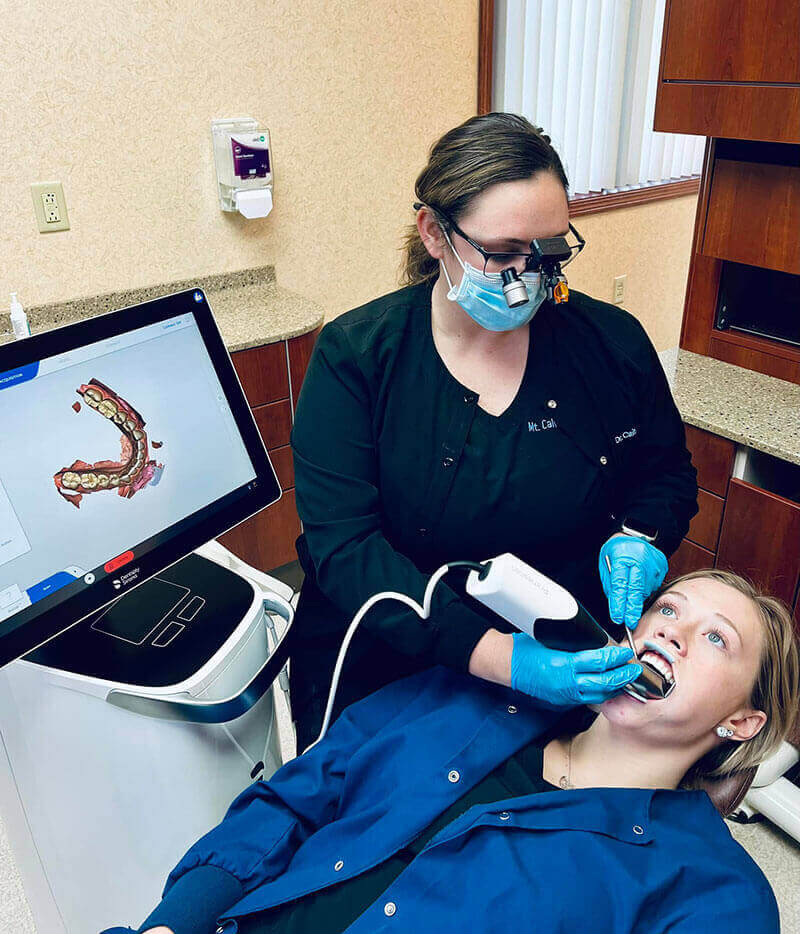Remember, your smile speaks before you even say a word!
|
Advanced Digital DentistryDigital dental scanning allows Dr. Biever to create a highly accurate 3-D map of your oral cavity that is then used to create a crown, clear orthodontic retainers, mouth guard, or other dental appliance you might need.
How is digital scanning different than using a dental mold?
|
Composite FillingsA composite (tooth colored) filling is used to repair a tooth that is affected by decay, cracks, fractures, etc. The decayed or affected portion of the tooth will be removed and then filled with a composite filling.
There are many types of filling materials available, each with their own advantages and disadvantages. You and your dentist can discuss the best options for restoring your teeth. Composite fillings, along with silver amalgam fillings, are the most widely used today. Because composite fillings are tooth colored, they can be closely matched to the color of existing teeth, and are more aesthetically suited for use in front teeth or the more visible areas of the teeth. As with most dental restorations, composite fillings are not permanent and may someday have to be replaced. They are very durable, and will last many years, giving you a long lasting, beautiful smile. Reasons for composite fillings:
|
How are composite fillings placed?Composite fillings are usually placed in one appointment. While the tooth is numb, your dentist will remove decay as necessary. The space will then be thoroughly cleaned and carefully prepared before the new filling is placed. If the decay was near the nerve of the tooth, a special medication will be applied for added protection. The composite filling will then be precisely placed, shaped, and polished, restoring your tooth to its original shape and function.
It is normal to experience sensitivity to hot and cold when composite fillings are first placed, however this will subside shortly after your tooth acclimates to the new filling. You will be given care instructions at the conclusion of your treatment. Good oral hygiene practices, eating habits, and regular dental visits will aid in the life of your new fillings. |
Request an AppointmentMt. Calvary Dental
Dr. Caitlin Biever, DDS 100 Evergreen Road Mt. Calvary, WI 53057 920-753-2771 Office Hours: Monday: 11:00 am - 7:00 pm Tues, Wed, Thurs: 7:00 am - 4:00 pm Friday: Closed |
Porcelain Crowns (Caps)A crown (or cap) is a covering that encases the entire tooth surface restoring it to its original shape and size. A crown protects and strengthens tooth structure that cannot be restored with fillings or other types of restorations.
Although there are several types of crowns, porcelain (tooth colored crown) are the most popular, because they resemble your natural teeth. They are highly durable and will last many years, but like most dental restorations, they may eventually need to be replaced. Porcelain crowns are made to match the shape, size, and color or your teeth giving you a natural, long-lasting beautiful smile. Reasons for crowns:
|
What does getting a crown involve?A crown procedure usually requires two appointments. Your first appointment will include taking several highly accurate digital scans that will be used to create your custom crown. A temporary crown will be created and stay on your tooth for approximately two weeks until your new crown is fabricated by our dental laboratory.
While the tooth is numb, the dentist will prepare the tooth by removing any decay and shaping the surface to properly fit the crown. Once these details are accomplished, your temporary crown will be placed with temporary cement and your bite will be checked to ensure you are biting properly. At your second appointment your temporary crown will be removed, the tooth will be cleaned, and your new crown will be carefully placed to ensure the spacing and bite are accurate. You will be given care instructions and encouraged to have regular dental visits to check your new crown. |
Porcelain VeneersVeneers are very thin pieces of durable, tooth shaped porcelain that are custom made (for shape and color) by a professional dental laboratory. They are bonded onto the front of teeth to create a beautiful and attractive smile.
Veneers can completely reshape your teeth and smile. They can often be alternatives to crowns and the ideal solution in treating many dental conditions. As with most dental restorations, veneers are not permanent and may someday need replacement. They are very durable and will last many years, giving you a beautiful long lasting smile. Reasons for porcelain veneers:
|
What does getting porcelain veneers involve?Getting veneers usually requires two visits to complete the process, with little or no anesthesia required during the procedure. The teeth are prepared by lightly buffing and shaping the surface to allow for the thickness of the veneer. A mold or impression of the teeth is taken and a shade (color) will then be chosen by you and the dentist.
On the second visit the teeth will be cleansed with special liquids to achieve a durable bond. Bonding cement is then placed between the tooth and veneer and a special light beam is used to harden and set the bond. You will receive care instructions for veneers. Proper brushing, flossing and regular dental visits will aid in the life of your new veneers. |
From a delighted patient...
|
"The entire staff is welcoming and friendly."
~Wanda Z. 5-Star Google Review |







